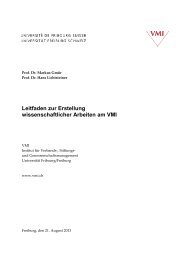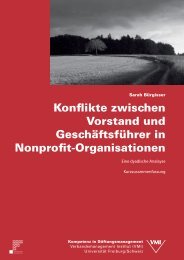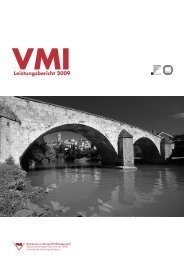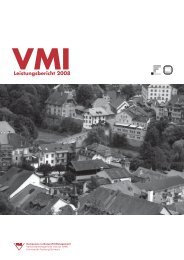Government Policy and the Nonprofit Sector: Switzerland - VMI
Government Policy and the Nonprofit Sector: Switzerland - VMI
Government Policy and the Nonprofit Sector: Switzerland - VMI
- TAGS
- nonprofit
- switzerland
- vmi.ch
You also want an ePaper? Increase the reach of your titles
YUMPU automatically turns print PDFs into web optimized ePapers that Google loves.
Nollert <strong>and</strong> Budowski <strong>Government</strong> <strong>Policy</strong> <strong>and</strong> <strong>the</strong> <strong>Nonprofit</strong> <strong>Sector</strong>: Switzerl<strong>and</strong><br />
The strong influence of NPOs is grounded in four institutions; <strong>the</strong> democratic device of referenda <strong>and</strong> initiatives,<br />
<strong>the</strong> consultation process, <strong>and</strong> <strong>the</strong> Federation Complaint Right. Institutions allow NPOs to disb<strong>and</strong> (by means of<br />
referendum), to advance (through initiatives), <strong>and</strong> to participate in <strong>the</strong> creation of legislation (consultation<br />
process). The Federation Complaint Right also allows NPOs to hinder planned construction. These devices are<br />
effective – as mentioned above – because large associations <strong>and</strong> many committees that organize initiatives or<br />
referenda have greater financial <strong>and</strong> human resources at <strong>the</strong>ir disposal than political parties. Fur<strong>the</strong>rmore,<br />
many interest groups are better able to put forward <strong>the</strong>ir views (e.g. against cuts in social welfare, tax increases,<br />
flight paths, or sexual predators) by means of collective protest than political parties specifically oriented<br />
towards general public welfare.<br />
A referendum (since 1874) is usually called for when a significant portion of <strong>the</strong> population does not agree with a<br />
law proposed by <strong>the</strong> Swiss Parliament. If a party, association, or private person is able to collect 50,000<br />
signatures within 100 days, <strong>the</strong> decision is submitted to popular vote. This vote is called a facultative<br />
referendum. A simple majority is needed for <strong>the</strong> decision to be accepted.<br />
In <strong>the</strong> case of changes to <strong>the</strong> constitution, or to participation in any organization of collective security or in<br />
supranational associations, a referendum is compulsory. This means that a popular vote is necessary in every<br />
case. However, a double majority must accept such a proposal; i.e. it must be accepted both by <strong>the</strong> majority of<br />
voters, as well as <strong>the</strong> majority of cantons.<br />
Since 1891 citizens <strong>and</strong> NPOs have been able to dem<strong>and</strong> a referendum on changes to <strong>the</strong> constitution by means<br />
of initiatives. If an initiative committee is able to collect <strong>the</strong> required 100,000 signatures within 18 months, a<br />
popular vote takes place. The Swiss population has rejected <strong>the</strong> majority of similar initiatives, such as <strong>the</strong> 1989<br />
initiative to abolish <strong>the</strong> Swiss army. Citizens’ initiatives may also deal with cantonal <strong>and</strong> municipal issues.<br />
In order to diminish <strong>the</strong> probability of losing a popular vote (always a potential threat for legislators), all political<br />
parties with <strong>the</strong> power to call for a referendum are included during <strong>the</strong> formulation stage of a proposal. This<br />
happens by means of <strong>the</strong> consultation process, <strong>the</strong> preliminary phase of legal proceedings. This stage checks<br />
whe<strong>the</strong>r governmental proposals are politically, financially, economically, ecologically, socially, or culturally<br />
significant with regard to accuracy of contents, possibility of successful implementation <strong>and</strong> social acceptance.<br />
The draft proposal is thus submitted to <strong>the</strong> cantons, to <strong>the</strong> parties represented in Parliament, to <strong>the</strong> governing<br />
bodies of municipalities, cities, <strong>and</strong> mountain regions, to umbrella organizations of economic bodies, as well to<br />
o<strong>the</strong>r possible interested groups or associations according to <strong>the</strong> matter concerned.<br />
The consultation process is m<strong>and</strong>ated by <strong>the</strong> Federal Council, <strong>and</strong> is organized <strong>and</strong> carried out by <strong>the</strong> relevant<br />
government department. Even individuals that are not invited to <strong>the</strong> consultation process may offer <strong>the</strong>ir input.<br />
All opinions connected with <strong>the</strong> consultation process are evaluated before <strong>the</strong> Federal Council marks out <strong>the</strong><br />
conditions for <strong>the</strong> proposal. If <strong>the</strong> proposal is sent to Parliament, <strong>the</strong> Federal councilors discuss <strong>the</strong> proposal in<br />
<strong>the</strong> knowledge of <strong>the</strong> results of <strong>the</strong> consultation process.<br />
15











